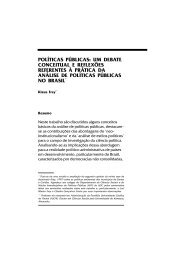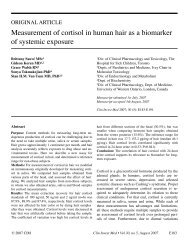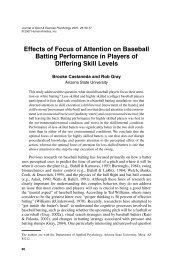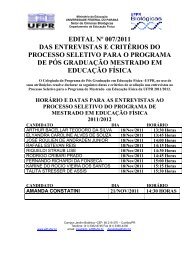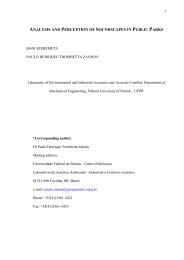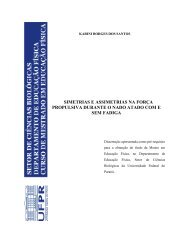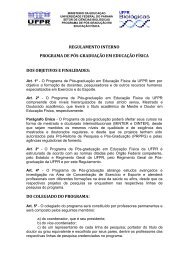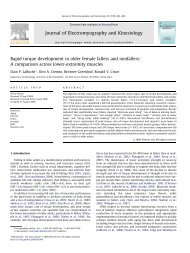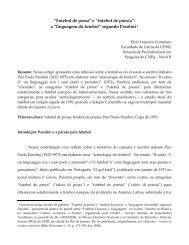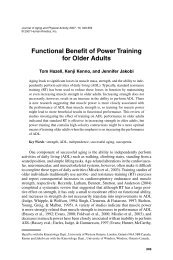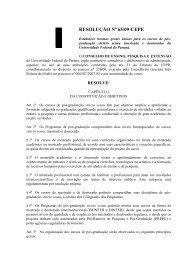Lactate threshold concepts - UFPR
Lactate threshold concepts - UFPR
Lactate threshold concepts - UFPR
You also want an ePaper? Increase the reach of your titles
YUMPU automatically turns print PDFs into web optimized ePapers that Google loves.
484 Faude et al.<br />
Table VI. Mean bias (difference maximal lactate steady state [MLSS]-LT) and 95% limits of agreement (LoA) for four different lactate<br />
<strong>threshold</strong> <strong>concepts</strong> during treadmill (n = 16) and cycle ergometry (n = 22). Results calculated from raw data reported by Heck et al. [49,50,72] (with<br />
permission)<br />
<strong>Lactate</strong> <strong>threshold</strong> concept<br />
Treadmill ergometry<br />
3 min stages, +0.4 m/s<br />
mean bias<br />
(m/s)<br />
LoA<br />
(m/s)<br />
LoA<br />
(%)<br />
Treadmill ergometry<br />
5 min stages, +0.4 m/s<br />
mean bias<br />
(m/s)<br />
LoA<br />
(m/s)<br />
LoA<br />
(%)<br />
Cycle ergometry<br />
2 min stages, +25 W<br />
mean bias<br />
(W)<br />
LT4 -0.13 –0.35 –8 0.02 –0.39 –9 -19.8 –28.4 –14<br />
IAT (Keul et al. [96] ) -0.20 –0.39 –9 0.06 –0.35 –8 -21.0 –22.4 –11<br />
IAT (Stegmann et al. [88] ) -0.03 –0.51 –12 -0.03 –0.37 –9 -15.0 –35.0 –18<br />
IAT (Bunc et al. [143] ) -0.33 –0.33 –8 -0.14 –0.37 –9 -71.4 –52.8 –27<br />
IAT = individual anaerobic <strong>threshold</strong>; LT4 = 4 mmol/L <strong>threshold</strong>.<br />
LoA<br />
(W)<br />
LoA<br />
(%)<br />
view it would be of interest to know the absolute<br />
variability of individual differences between the<br />
LT and MLSS. An appropriate means to report<br />
this variability may be the mean bias and the 95%<br />
LoA as it was described by Bland and Altman.<br />
[194] There is only one study available that<br />
applied this procedure. [103] Such a procedure<br />
would also allow for assessing heteroscedasticity<br />
(i.e. whether the differences depend on the magnitude<br />
of the mean or – in this case – endurance<br />
capacity). [195]<br />
Table VI shows an example calculation of the<br />
mean bias and the 95% LoA for four different LT<br />
<strong>concepts</strong> from raw data reported by Heck et<br />
al. [49,50,72] These data show a mean bias between<br />
0.5% and 8%, with LoA of about 10% in a running<br />
exercise. This means that for each new<br />
subject within the study population it could be<br />
expected (with a 95% probability) that the difference<br />
between MLSS and the respective LT is<br />
within these LoA. [195] For the cycling exercise the<br />
results are more heterogenous with greater mean<br />
bias and LoA. However, due to the limited data<br />
points these observations are preliminary and<br />
should be confirmed by further research.<br />
5. Conclusions and Perspectives<br />
In conclusion, it can be stated that a huge<br />
amount of evidence exists that LT <strong>concepts</strong> are of<br />
considerable importance for the diagnosis as well<br />
as the prediction of aerobic endurance performance.<br />
The concept of the aerobic-anaerobic<br />
transition may serve as a reasonable means for<br />
performance diagnosis and intensity prescription<br />
in endurance sports. However, there are several<br />
open questions that should be appropriately<br />
addressed by future research. These are:<br />
Whereas the relationship of LTs with competition<br />
performance is well established in running<br />
events and less strongly in cycling, there is lack<br />
of evidence for most other endurance sports.<br />
Scientific studies comparing LTs with MLSS<br />
are rare and the results are partially conflicting.<br />
This might be due to different methodological<br />
approaches. It is suggested that the<br />
MLSS be assessed by the established procedure<br />
using several constant load trials with<br />
different intensities [72,115] and that the MLSS<br />
be compared with a chosen LT. To do so,<br />
measures of absolute agreement between LTs<br />
and MLSS should be reported according<br />
to the method introduced by Bland and<br />
Altman. [194]<br />
In this context, it is important to know the basic<br />
variability and reproducibility of the MLSS. Up<br />
to now, no scientific data addressing this question<br />
exist. Therefore, it is recommended to evaluate<br />
the variability of MLSS in future research.<br />
Of note, this may enable an evaluation of the<br />
differences between LT and MLSS compared<br />
with the basic variability of the MLSS and,<br />
thus, give more detailed information on the<br />
quality of the MLSS estimate.<br />
Although there has been much and controversial<br />
debate on the LT phenomenon during<br />
the last three decades, many scientific studies<br />
have dealt with LT <strong>concepts</strong>, their value in as-<br />
ª 2009 Adis Data Information BV. All rights reserved. Sports Med 2009; 39 (6)



